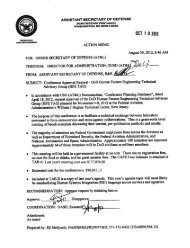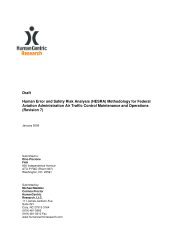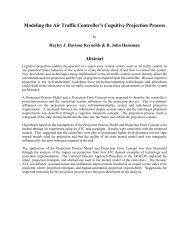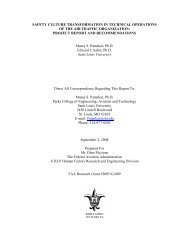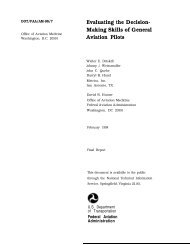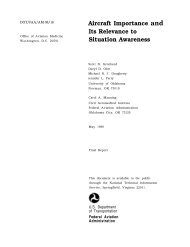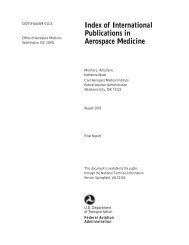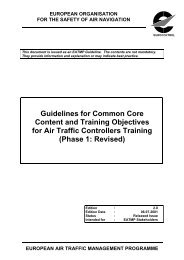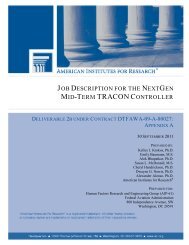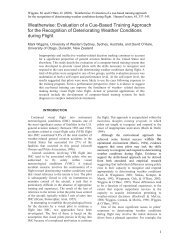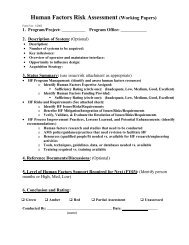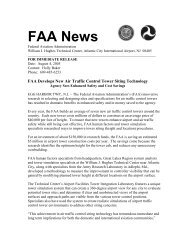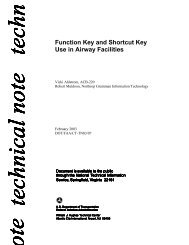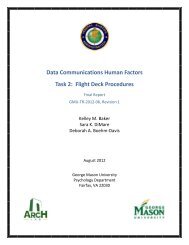job description for the nextgen mid-term atct controller - FAA Human ...
job description for the nextgen mid-term atct controller - FAA Human ...
job description for the nextgen mid-term atct controller - FAA Human ...
You also want an ePaper? Increase the reach of your titles
YUMPU automatically turns print PDFs into web optimized ePapers that Google loves.
OI No. OI Name<br />
104207 Enhanced Surface Traffic Operations<br />
104209 Initial Surface Traffic Management<br />
105208 Traffic Management Initiatives with Flight Specific Trajectories<br />
107115 Low Visibility/Ceiling Takeoff Operations<br />
107117 Low Visibility/Ceiling Departure Operations<br />
107118 Low Visibility/Ceiling Landing Operations<br />
107119 Expanded Low Visibility Operations using Lower RVR Minima<br />
107202 Low Visibility Surface Operations<br />
109305 Improved Safety <strong>for</strong> NextGen Evolution<br />
109402 Remotely Staffed Tower Services<br />
102123 ADS-B Separation<br />
107103 RNAV SIDS, STARS and Approaches<br />
De<strong>term</strong>ine Comprehensiveness of Draft List of Drivers<br />
Reaching consensus regarding which OIs are most relevant <strong>for</strong> which facility types allowed<br />
researchers to focus on those OIs when evaluating <strong>the</strong> impact on <strong>the</strong> <strong>job</strong> <strong>for</strong> a specific facility<br />
type. Ano<strong>the</strong>r challenge, however, was understanding how <strong>the</strong> specific changes to <strong>the</strong> ATCS<br />
work environment that AIR had already begun drafting related to this list of OIs. That is, AIR<br />
had already identified a list of technologies, automation, and procedures that have been proposed<br />
to occur in <strong>the</strong> NextGen <strong>mid</strong>-<strong>term</strong> and that will most likely and most directly affect <strong>the</strong> work<br />
environment (and hence <strong>the</strong> <strong>job</strong>) of <strong>the</strong> ATCS in <strong>the</strong> ATCT environment:<br />
• 4-Dimensional Wea<strong>the</strong>r Data Cube (4-D Wx Data Cube)<br />
• Airport Surface Detection Equipment-Model X (ASDE-X)<br />
• Automatic Dependent Surveillance-Broadcast (ADS-B)<br />
• Data Communications (Data Comm)<br />
• Integrated Arrivals and Departures (IADS)<br />
• Terminal Automation Modernization and Replacement (TAMR)<br />
• Tower Flight Data Manager (TFDM)<br />
• Wake Turbulence Mitigation <strong>for</strong> Departures (WTMD)<br />
To ensure that this list of Drivers was comprehensive, AIR researchers independently assigned<br />
<strong>the</strong>se Drivers to <strong>the</strong> OIs identified <strong>for</strong> <strong>the</strong> ATCT environment and <strong>the</strong>n reconvened and discussed<br />
<strong>the</strong>m to reach consensus. The results suggest that <strong>the</strong> list of Drivers was complete. All <strong>the</strong><br />
ATCT Drivers were mapped onto at least one OI. With <strong>the</strong> exception of one OI (OI 105302-<br />
Continuous Flight Day Evaluation), each OI had at least one ATCT Driver mapped onto it.<br />
Although <strong>the</strong> strategic analysis required to support continuous flight day evaluation is likely to<br />
be <strong>the</strong> responsibility of system engineers, it is not clear whe<strong>the</strong>r or how line <strong>controller</strong>s will be<br />
required to contribute to this improvement. Note that some OIs require a Driver that will not be<br />
fully operational by 2018. For example, OI 102118 (Delegated Responsibility <strong>for</strong> In-Trail<br />
Separation) will require Automatic Dependent Surveillance-Broadcast In (ADS-B In), which will<br />
not be widely available by 2018.<br />
16



